We explain what the Egyptian gods are and the main beliefs of the Egyptian religion. In addition, its general characteristics and classification.
What are the Egyptian gods?
The Egyptian gods are a group of deities belonging to the religion of Ancient Egypt (3150 BC – 31 BC), one of the main ancient civilizations of North Africa. This civilization prospered on the banks of the Nile River , expanding its cultural, economic, and political influence as far as the Euphrates, the Red Sea , the Sinai Peninsula, and part of the Mediterranean .
Ancient Egyptian religion was polytheistic (many gods) and involved a diverse and complex set of rituals . Thanks to them, human beings could obtain the favor of the gods, regents of natural forces.
However, unlike many other ancient religions, they did not concern themselves with ephemeral phenomena such as rainbows or eclipses , nor with fundamental elements such as fire and water . In addition, the areas of influence of each god could be difficult to define and were often flexible, changing, according to their mythical accounts .
Where they did have an important presence was in the political organization of society , and the pharaohs were often their representatives on earth. The cult of the dead , of importance in Egyptian society, was also a territory dominated by deities.
Origin of the Egyptian gods

The Egyptian religion took its first steps in Egyptian prehistory.
There is not much archaeological record of them .
It is likely that each Egyptian region had its own tutelary god .
However, it is believed that the conquest or absorption of some communities by others was imposing some on others.
Thus, some gods gained importance, but the others were not completely lost.
Around the year 3000 a. C. Egyptian cities are unified to start the Early Dynastic Period . The imperial organization imposed a pantheon of gods of national importance.
Furthermore, the cult of the pharaoh (who embodied the god Horus on Earth ) was given in terms of his tutelary gods. Simultaneously, the priests had the task of making a huge number of deities coexist in the same pantheon that would guarantee a unified religion.
Throughout the Old, Middle, and New Egyptian Empire, the worship of the gods was organized according to ruling elites . Subsequently, periods of Babylonian , Mycenaean , and finally Greek and Roman occupation weakened their identity and fostered syncretism .
In the first centuries AD. C. diverse edicts of the Roman emperors prohibited the cult to the goddess Isis . In this way, what remained of the traditional Egyptian religion became extinct.
Main beliefs of the Egyptians

Egyptian religion was not a monolithic, homogeneous set of ritual practices. On the contrary, it encompassed an enormous variety of beliefs and practices, which had in common the link between the world of the sacred and the world of humans.
Its basic precepts can be summarized as:
- The Maat . This term summarizes the fundamental values of Egyptian cosmology, such as truth, justice and order; concepts that created a single fixed and eternal order of the universe , constantly besieged by the forces of chaos and destruction. The Ma'at implied at the same time the balance of the natural forces of the cosmic order, and the joint tasks of human society.
- the pharaohs Royal authority was, for the Egyptians, a manifestation of divine force. Although the kings were human, they were understood to be incarnations of divine will, intermediary between the gods and humans. And when they died, the pharaohs were deified and assimilated with some tutelary god, who was represented in their majestic tombs.
- the ka . This is the name given to the vital force of humans, which is released from the body at the time of death, and which was nourished by food and drink. On the contrary, in the body resided the person's ba , a series of unique spiritual characteristics, which had to be released through mortuary preparation. Thus, Egyptian funerals consisted of giving food and drink to the ka , and releasing the ba so that together they would form an akh and assimilate to the gods.
Egyptian pantheon
The Egyptian pantheon was diverse and huge, with thousands of deities and gods organized into two sets:
- The lesser gods or demons. With local or very limited functions, especially associated with regions of the Empire or with very specific effects.
- The older gods. Of vital importance in the maintenance of the universe and protagonists of the foundational religious stories, whose cult was sustained throughout the Empire.
However, the main gods were represented more concretely and recurrently. Animals or anthropomorphic figures with animal heads were used for this.
Ra, God of the Sun
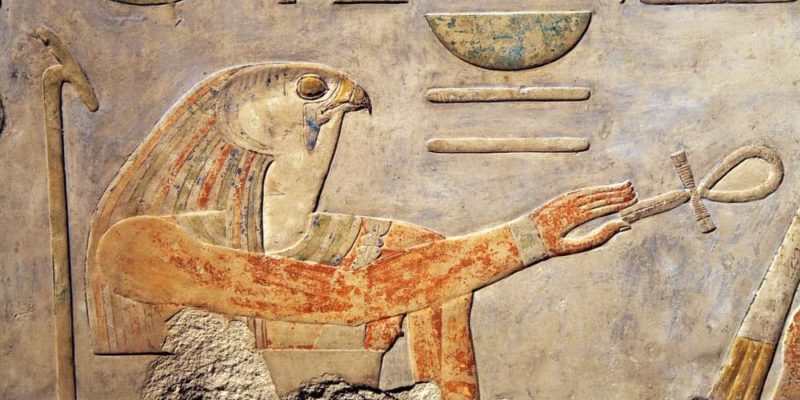 One of the deities associated with the Sun , he was represented as a human figure with the head of a falcon , although depending on his place in the sky he could assume three different forms or appearances:
One of the deities associated with the Sun , he was represented as a human figure with the head of a falcon , although depending on his place in the sky he could assume three different forms or appearances:
- Jeper. The scarab represents the morning rising Sun in the East.
- Ra. The falcon that illuminates the earth during the day.
- Aton. A bent old man who warms the dead in the afterlife, when the Sun disappeared in the west.
Isis, the mother goddess
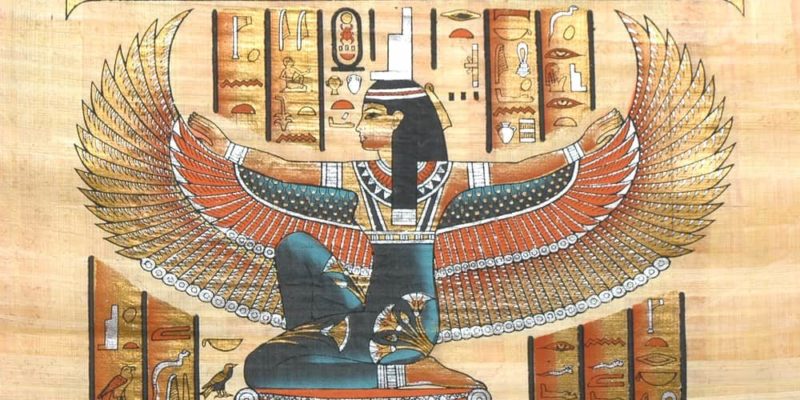 The "mother of the gods", who personified the very throne of the Empire , and the most popular of all the deities of the pantheon. She embodies the role of the mother and the wife, being the mother of Horus and the wife of Osiris. She is depicted as a human figure with a throne on her head and sometimes with wings as well.
The "mother of the gods", who personified the very throne of the Empire , and the most popular of all the deities of the pantheon. She embodies the role of the mother and the wife, being the mother of Horus and the wife of Osiris. She is depicted as a human figure with a throne on her head and sometimes with wings as well.
Osiris, the first mummy
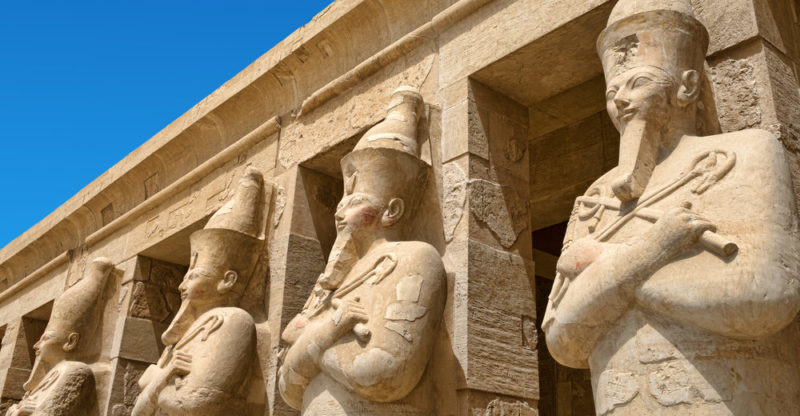 It is linked to agriculture and the vegetation that grows from the ground . In addition, he is the regent of the world of the dead , to whom he grants eternal life at his side.
It is linked to agriculture and the vegetation that grows from the ground . In addition, he is the regent of the world of the dead , to whom he grants eternal life at his side.According to the religious story, Osiris married his sister Isis and was heir to the throne of the earth . However, this was not possible because his brother Seth killed him. Furthermore, to prevent his resurrection, he tore him to pieces, scattering him over the earth.
So his wife Isis, along with her sister Nephthys, picked up each piece. When they managed to unite them all, they embalmed him with the help of Anubis . This is how he became the first mummy in Egypt.
Horus, the falcon god
 Son of Isis and Osiris, he is represented with a falcon's head on which the throne rests . He is also depicted as a falcon with the double Egyptian crown on his head (for Upper and Lower Egypt). He is the god of the sky and the ruler of the kingdom of human beings. His eyes are the moon and the sun, and the pharaoh in his incarnation on earth.
Son of Isis and Osiris, he is represented with a falcon's head on which the throne rests . He is also depicted as a falcon with the double Egyptian crown on his head (for Upper and Lower Egypt). He is the god of the sky and the ruler of the kingdom of human beings. His eyes are the moon and the sun, and the pharaoh in his incarnation on earth.
Seth the destruction
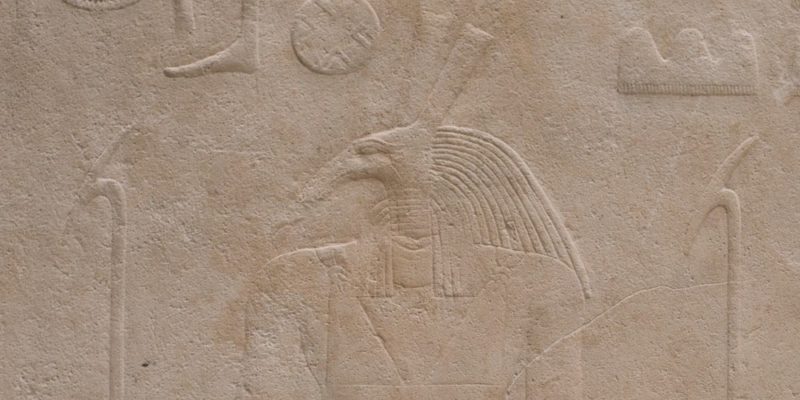 Set or Seth personified brute force, death, and destruction , especially arid lands, desert , and drought . His voice was that of thunder and from time to time he threatened the cosmic order, making it impossible to destroy him definitively.
Set or Seth personified brute force, death, and destruction , especially arid lands, desert , and drought . His voice was that of thunder and from time to time he threatened the cosmic order, making it impossible to destroy him definitively.According to Egyptian accounts , he was the murderer of his brother Osiris, whom he tore to pieces to keep his throne. However, after being defeated by Horus, he was sentenced to live in the desert. He was usually depicted as a human figure with the head of an aardvark.
Anubis, guide of souls
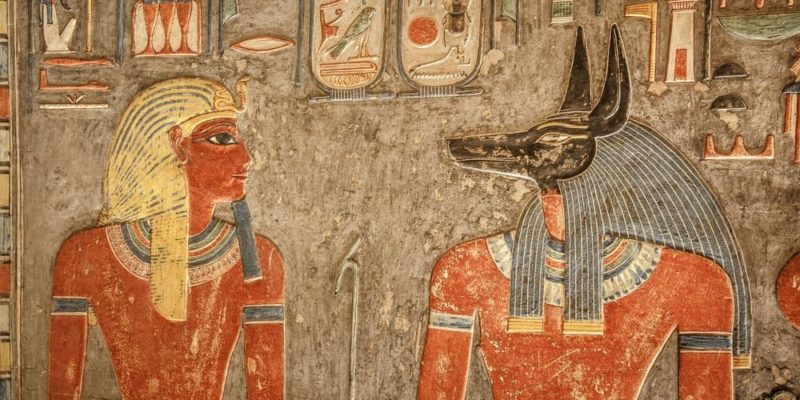 The guardian of the necropolis and guide of the deceased. He ruled over all kinds of funerary trades and was credited with having guarded the body of Osiris during his mummification. He was depicted as a human with the head of a black jackal or a dog. He joined the cult of Osiris, thus becoming the son of Nephthys.
The guardian of the necropolis and guide of the deceased. He ruled over all kinds of funerary trades and was credited with having guarded the body of Osiris during his mummification. He was depicted as a human with the head of a black jackal or a dog. He joined the cult of Osiris, thus becoming the son of Nephthys.
Nephthys, the lady of the house
 She was the wife of Seth and lover of Osiris. Also, some traditions point to her as the mother of Anubis . This goddess was represented with the emblem of the tomb-house on her head. In that sense, he was the embodiment of eternal repose and the mummy's bandages represented his hair.
She was the wife of Seth and lover of Osiris. Also, some traditions point to her as the mother of Anubis . This goddess was represented with the emblem of the tomb-house on her head. In that sense, he was the embodiment of eternal repose and the mummy's bandages represented his hair.In addition to being associated with the funeral cult, travelers asked for help when crossing hostile territories , such as deserts. His magical powers were what allowed Osiris's body to be reunited.
The above content published at Collaborative Research Group is for informational and educational purposes only and has been developed by referring to reliable sources and recommendations from technology experts. We do not have any contact with official entities nor do we intend to replace the information that they emit.
Luke is passionate about fostering student involvement and connection. He studied psychology for his major and likes learning about the past. Luke aims to specialize in artificial intelligence and cybersecurity. .
Leave a reply
Your email address will not be published. Required fields are marked *Recent post

Sport: What Is It, Types, Risks, Features, Characteristics and Examples

Dogs: Emergence, Features, Characteristics, Feeding and Breeds

Story: Definition, Elements, Structure, Features and Characteristics

